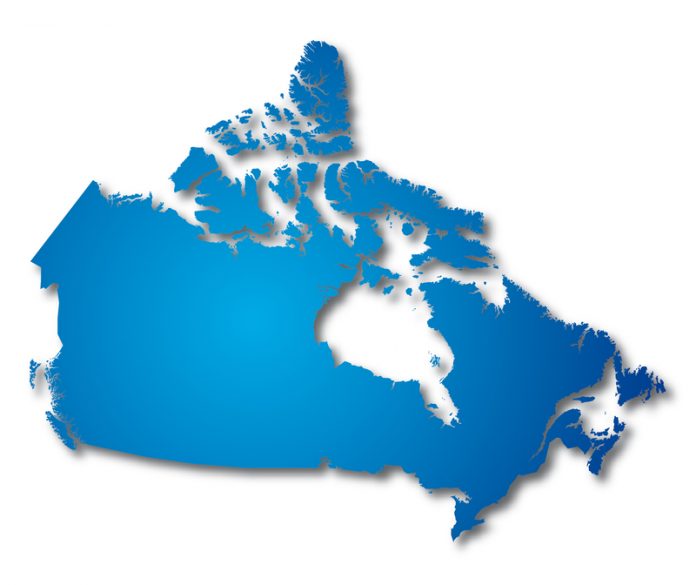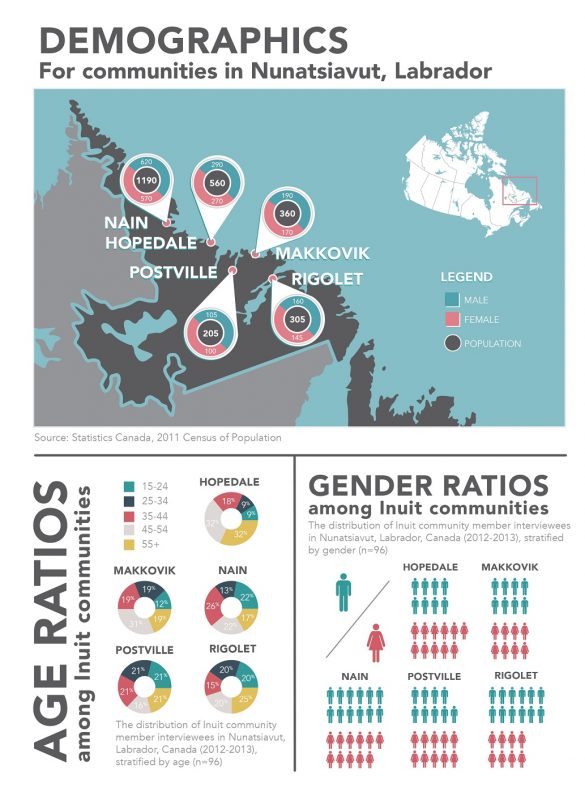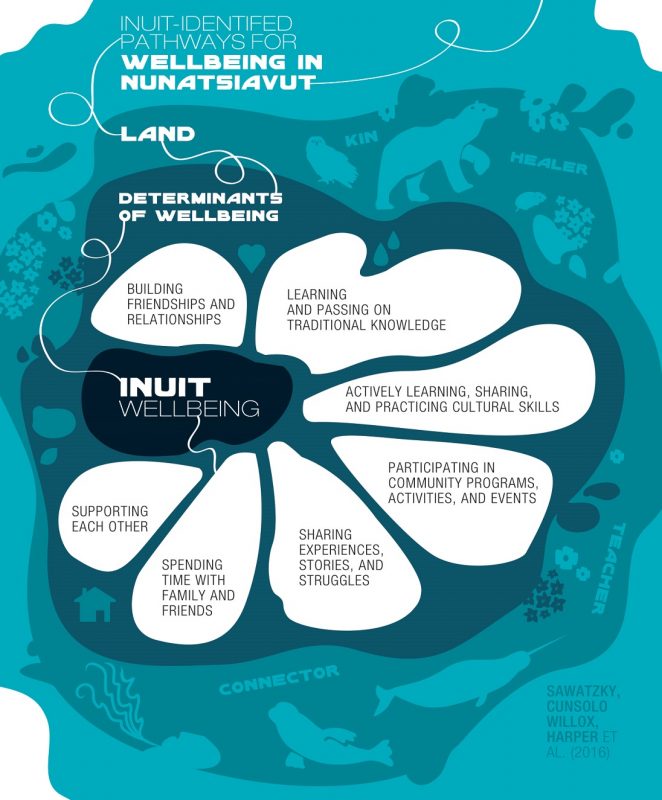Alexandra Sawatzky, Ashlee Cunsolo, and Sherilee Harper highlight the need for regional perspectives on Inuit-specific pathways for wellbeing
Understanding the context-specific nature of Inuit relationships with the land is essential when developing and implementing public health policy and programs that aim to enhance Inuit wellbeing in culturally-appropriate ways. Collaborative efforts to continue strengthening the formation, implementation, and evaluation of public health strategies are needed, and must be firmly rooted in Indigenous knowledge, ways of life, and connection to the land.
Drawing from a multi-year, multi-community, community-led and community-based participatory case study based in the Inuit region of Nunatsiavut, Labrador, Canada, and this project had 3 main objectives:
- Characterise conceptualisations of wellbeing and its underlying components from the perspectives of Inuit living in Nunatsiavut;
- Describe pathways through which Inuit in this region achieve and maintain good wellbeing; and
- Compare protective factors for wellbeing at both individual and community levels.
Nunatsiavut, Labrador, Canada
The Inuit Settlement Region of Nunatsiavut is located on the North coast of Labrador, Canada. Formed in 2005 as a result of the Labrador Inuit Land Claims Agreement, it is the first of the Inuit land regions in Canada to achieve full self-governance. Nunatsiavut is comprised of five small, remote, fly-in only communities (from North to South): Nain, Hopedale, Postville, Makkovik, and Rigolet (Fig. 1).
Led by the Rigolet Inuit Community Government, and working in partnership with the Inuit Community Governments of Nain, Hopedale, Postville, and Makkovik, and the Nunatsiavut Government Department of Health and Social Development, this project responded to Inuit-identified needs and priorities for locally-specific environment and health research.
Figure 1. Map and demographic composition of Nunatsiavut communities and participating community members (2012-2013)
The Land is Essential to Wellness: ‘it helps people’s hearts feel better’
Across all interviews, it was clear that understanding Inuit relationships with the land was essential to discovering pathways to locally-connected health and wellness. While relationships with the land were highly personal – dependent on each individual’s unique history and experiences – almost every interviewee felt that the land was foundational to all aspects of Inuit life, culture, livelihoods, and overall wellbeing.
Going out on the land is everything to us – it’s our heart and our soul. That’s real. A lot of people think of spirituality as just a church thing and it’s not, that’s just one portion of spirituality. For us, going out on the land is a form of spirituality and if you can’t get there, then you almost feel like your spirit is dying and then when you get out again, then you feel so much better when you come back. I think it energises you more and just frees your spirit more by being out on the land.
Culture as the Cornerstone of Inuit-Identified Pathways for Wellbeing: ‘culture isn’t just a people; it’s a way’
“Going off” on the land to learn and share traditional skills not only helped people to connect to their cultural roots, but also helped them to connect to each other and to their communities. Going off on the land was also commonly mentioned as one of the best ways to develop and use traditional knowledge, while simultaneously fostering health and wellbeing. It was expressed that passing on knowledge surrounding land-based traditions and cultural skills to the younger generations was especially important.
Building Relationships Supports Wellbeing: ‘…Inuit needs more support peoples…more connectedness to other people’
Relationships with family and friends provided individuals with a network of support that was important for good wellbeing, and that people need to foster this connection through family time and land time. The majority of participants identified that going off on the land with friends and family was essential for strengthening relationships. Friends and families who went off on the land together said they were able to connect on a deeper level, and develop healthy, strong relationships while also creating memories.
A Sense of Community Strengthens Collective Wellness: ‘there’s a lot of good, strong community support here’
Many individuals felt that community programmes, gatherings, and events could positively impact on health and wellbeing by enhancing their sense of belonging, whether in the community or on the land. These programmes were viewed as opportunities to share day-to-day experiences, stories, and struggles with fellow community members. Emphasis was placed on the benefits of using the land as a space to provide both formal and informal programming to build supportive connections within and between various groups. People from all age groups said they valued land-based programming, but it was said to be particularly beneficial for youth.
Inuit-Identified Pathways for Wellbeing Lead to Self-Determination: ‘…just do what you want to do and be happy doing it’
The independent creation and pursuit of pathways for good wellbeing that were Inuit-specific and land-based helped people realise that they “can choose the way that they live,” and that life was “all about making their own choices.” This sense of self-determination based on cultural sovereignty was strengthened by “doing things that you want to do instead of doing things that other people want you to do,” and being “able to exercise [their] Aboriginal rights.” Not only did the land encompass community-wide conceptions of wellbeing that were tied to culture and supportive relationships, it also provided the space for individuals to create and pursue pathways to wellbeing that led to meaningful outcomes that were locally- and culturally- appropriate and relevant (Fig. 2).
Figure 2. Pathways to wellbeing, as identified by Inuit in Nunatsiavut, Labrador.
Moving Forward
This research demonstrates how Inuit in Nunatsiavut are actively creating and pursuing pathways for wellbeing, which will help to guide future research and policies in this region that aim to enhance wellbeing in relevant and meaningful ways. Further, it places Inuit voices, culture, ways of knowing, and conceptualisations of health and wellbeing at the centre of decision-making and action.
Re-shaping and re-defining frameworks for research and policy so that they authentically represent Inuit-identified health and wellbeing definitions and priorities presents many benefits and opportunities for preserving and promoting Inuit culture, identity, and wellbeing within the context of strengthening healthcare provision, programming, and policies across the North.
Key Partners & Collaborators
Jack Shiwak & Charlotte Wolfrey, Rigolet Inuit Community Government | Inez Shiwak & Marilyn Baikie, ‘My Word’: Storytelling & Digital Media Lab | Herb Jacque & Myrtle Groves, Makkovik Inuit Community Government | Diane Gear & Greg Jacque, Postville Inuit Community Government | Wayne Piercy & Juliana Flowers, Hopedale Inuit Community Government | Anthony Andersen & Noah Nochasak, Nain Inuit Community Government | Michele Wood, Nunatsiavut Department of Health & Social Development
Funding
- Health Canada’s First Nations and Inuit Health Branch
- Nasivvik Centre for Inuit Health and Changing Environments
- Nunatsiavut Government’s Department of Health and Social Development
- Canada Research Chairs program.
Ashlee Cunsolo Willox, PhD
Canada Research Chair in Determinants of Healthy Communities Assistant Professor of Community Health
Departments of Nursing and Indigenous Studies
ashlee_cunsolowillox@cbu.ca
https://ashleecunsolowillox.ca
Please note: this is a commercial profile













